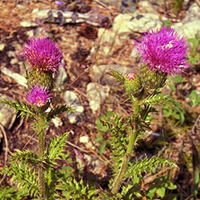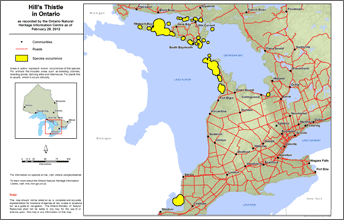Hill’s thistle
Scientific name: Cirsium hillii

Cover photo credit: Wasyl Bakowsky
Status
Threatened
“Threatened” means the species lives in the wild in Ontario, is not endangered, but is likely to become endangered if steps are not taken to address factors threatening it.
Date added to the Species at Risk in Ontario List
The Hill’s Thistle was already assessed as threatened when the Endangered Species Act took effect in 2008.
What it looks like
Hill’s Thistle is a perennial thistle that reaches a height of 25 to 60 centimetres. The stems are soft and covered with fine hairs. It has a few smooth or slightly hairy leaves that taper to the tip and are shallowly lobed.
A few branches near the top of the stem produce one or several large flowering heads that contain many tiny pink-purple (rarely white) flowers. At the base of the plant there is a flat spiral of long oval-shaped leaves.
Where it lives
In Ontario, Hill’s Thistle is found in open alvar grasslands, surrounded by forests of Jack Pine, White Spruce, and Eastern White Cedar.
Alvars are flat areas of limestone bedrock with very shallow soil and vegetation consisting of scattered trees, shrubs and grasses.
This sun-loving thistle is also found in prairie and sand dunes. These are all rare habitats in Ontario, characterized by open and sunny conditions.
Where it’s been found in Ontario
Hill’s Thistle is only found near the Great Lakes of North America. In Canada, following an assessment in 2004, Hill’s Thistle is believed to persist at 64 sites in southern Ontario. It is mainly found on Manitoulin Island, and on the west side of the Bruce Peninsula.
View a larger version of this map (PDF)
What threatens it
The main threat to Hill’s Thistle in Ontario is the lack of suitable habitat.
Hill’s Thistle prefers sunny sites, especially openings in woodland, but these habitats are undergoing natural succession (a series of predictable changes over time in the kinds of plants growing in an area) as shrubs and trees gradually invade open areas.
Wildfires can be used to create open habitats suitable for Hill’s Thistle by limiting natural succession. Today, most areas are managed for fire. As a result, many of the open areas where Hill’s Thistle grows are reverting to woodland and becoming too shaded.
Hill’s Thistle is often found growing close to shoreline areas, and these areas are prime sites for cottage development. Other human activities, such as quarrying and ornamental stone removal, ATV traffic and physical trampling, also pose threats.
Action we are taking
Threatened Species and their general habitat are automatically protected
Recovery strategy
A recovery strategy advises the ministry on ways to ensure healthy numbers of the species return to Ontario.
Read the executive summary (May 31, 2013)
Read the recovery strategy (May 31, 2013)
Government response statement
A government response statement outlines the actions the government intends to take or support to help recover the species.
Read the government response statement (March 14, 2014)
Review of progress
A review of progress made toward protecting and recovering a species is required no later than the time specified in the species’ government response statement, or not later than five years after the government response statement is published if no time is specified.
Read the report on progress towards the protection and recovery of 16 species at risk, including Hill’s Thistle (Cirsium hillii) (2019).
Habitat protection
General Habitat Protection - June 30, 2013
What you can do
Report a Sighting
- The Ministry of Natural Resources and Forestry tracks species at risk such as the Hill’s Thistle. You can use a handy online form to report your sightings to the Natural Heritage Information Centre. Photographs with specific locations or mapping coordinates are always helpful.
Volunteer
- Volunteer with your local nature club or provincial park to participate in surveys or stewardship work focused on species at risk.
Be a good steward
- Private land owners have a very important role to play in species recovery. If you find Hill’s Thistle on your land, you may be eligible for stewardship programs that support the protection and recovery of species at risk and their habitats.
- Invasive species seriously threaten many of Ontario’s species at risk. To learn what you can do to help reduce the threat of invasive species, visit:
- Hill’s Thistle and many other species at risk depend on healthy grassland prairies, a very rare habitat in Ontario. Learn more about these habitats, the species that depend on them, and what you can do to help
- Pollinators, such as bees, are in steep decline across the globe and they play a key role in the survival of many of Ontario’s rare plants. For information on how you can help scientists monitor pollinator populations in Ontario visit Seeds of Diversity.
Report illegal activity
- Report any illegal activity related to plants and wildlife to
1-877-TIP-SMNR (847-7667) .
Quick facts
- Hill’s Thistle grows on alvars – one of the rarest habitats in North America. These barren-looking landscapes of exposed bedrock support an amazing diversity of plants and insects.
- In Ontario, Hill’s Thistle often grows with other species at risk such as Lakeside Daisy and Houghton’s Goldenrod.
